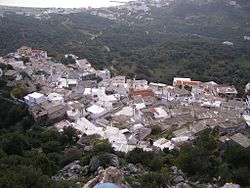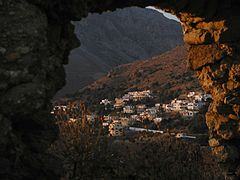Myrthios
|
Local community Myrthios Τοπική Κοινότητα Μύρθιου (Μύρθιος) |
||
|---|---|---|
|
|
||
| Basic data | ||
| Country |
|
|
| region | Crete | |
| Regional district | Rethymno | |
| local community | Agios Vasilios | |
| Geographic coordinates | 35 ° 12 ' N , 24 ° 24' E | |
| Height above d. M. |
200 m (average) |
|
| surface | 8.298 km² | |
| Residents | 488 (2011) | |
| Population density | 58.81 inhabitants / km² | |
| LAU-1 code no. | 931109 | |
| Local division | 6 settlements | |
| Myrthios seen from above | ||
Myrthios ( Greek Μύρθιος [ ˈmirθjɔs ] ( f. Sg. )) Is a mountain village near the south coast of the Greek Mediterranean island of Crete . Myrthios is a local community in the municipality of Finikas in the municipality of Agios Vasilios . The municipality belongs to the regional district of Rethymno .
Myrthios also includes the places and corridors Kalypso (Καλυψώ), Kambos (Κάμπος), Kokkina Chorafia (Κόκκινα Χωράφια), Finix (Φοίνιξ) as well as the eastern part of Plakias ( Μυρθινόάς) λακθινός άς . The entire village of Myrthios has 488, the village itself 203 inhabitants (according to the 2011 census).
description
The name of the place is derived from that of the myrtle bush (Μυρτιά) or its berry (Μύρτο). The village is mentioned in a census as early as 1577. Parts of the existing buildings are more than 200 years old, but many buildings in the upper part of the village have fallen into disrepair, as the life activity of the residents has shifted more and more to the through road to Plakias . Today there are some taverns, shops and guesthouses there, which are highly frequented in summer due to the beautiful location above the nearby bay.
The main livelihood of the few residents outside of tourism is olive cultivation , until the 1980s the processing of the fruits of the carob tree also played a role. The carob trees are still the most common deciduous trees in the area after the olives. A large part of the old building fabric is made up of so-called Kamara houses . This type of stone house is typical of the area and neighboring Sfakia . The most striking feature is a longitudinal arch made of stone in the middle of the house, which supports the roof beams and enables the use of shorter pieces of wood. Often the original houses can only be identified from the inside as a Kamara house due to the nested extensions and superstructures. In the upper part of Myrthios the ruins of an unusually large two-story Kamara house can be found.
For the year 2005 Myrthios was awarded by the prefecture of Rethymno as “one of the cleanest villages of the year”, whereby both aesthetic and ecological aspects were taken into account.
- Myrthios in front of the Kotsifou Gorge
Myrthios watermill
The horizontal wheel water mill located below the village is worth seeing . She did not work with the usual mill wheel with a horizontal axis, but with a horizontal water wheel (i.e. with a vertical axis). A diversion to the horizontal millstone was therefore not necessary. The water from a creek flowing down the slope was led via an aqueduct protruding into the valley to a brick chimney-like downpipe, at the lower end of which, about 12 meters lower, it was directed through a side outlet onto the horizontal paddle wheel. This type of construction can be seen as the predecessor of the Pelton turbine .
Mills of this type are also known from other areas of the Mediterranean; they are particularly suitable for bodies of water with little or strongly changing amounts of water. According to Rackham & Moody , a few hundred of these mills have been mapped on Crete, and there may have been over a thousand in total.
In the vicinity of Myrthios are the remains of a few other mills, but none is as well preserved as the one directly below the village. Even the remains of the iron water wheel can still be found in a rock niche below the downpipe. According to local residents, the wheat mill was in operation until the mid-1960s.
Sons and daughters
Georgios N. Chatzidakis (Γεώργιος Ν. Χατζιδάκης, 1848–1941), a well-known Greek linguist, who in the 19th and early 20th centuries took a position for the Katharevousa as the state language in the Greek language dispute, was born in Myrthios.
literature
- Oliver Rackham, Jennifer Moody: The making of the Cretan landscape . 1996, Manchester University Press. ISBN 0-7190-3647-X
Individual evidence
- ↑ a b Results of the 2011 census at the National Statistical Service of Greece (ΕΣΥΕ) ( Memento from June 27, 2015 in the Internet Archive ) (Excel document, 2.6 MB)





